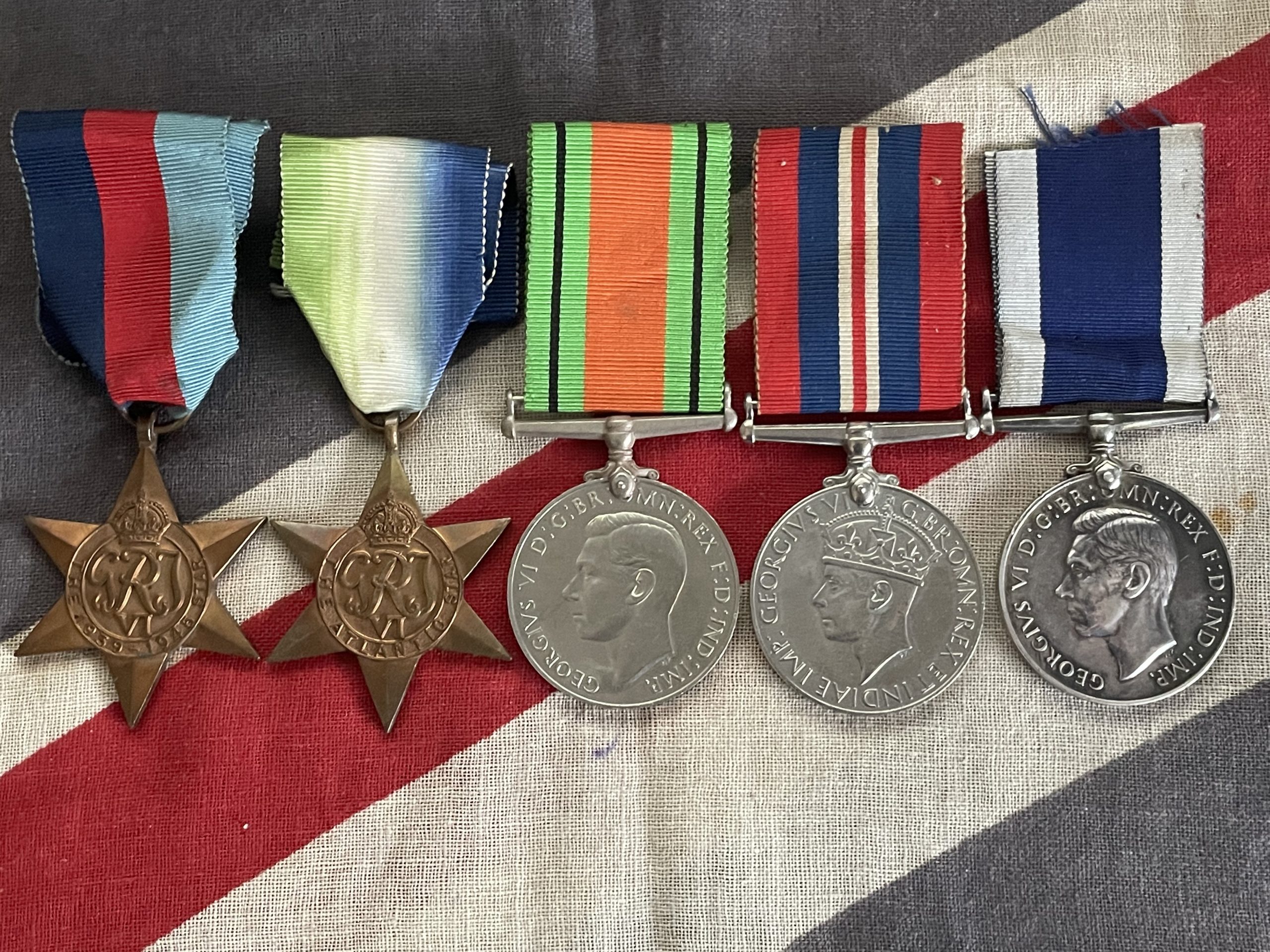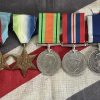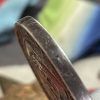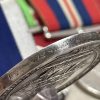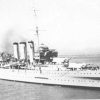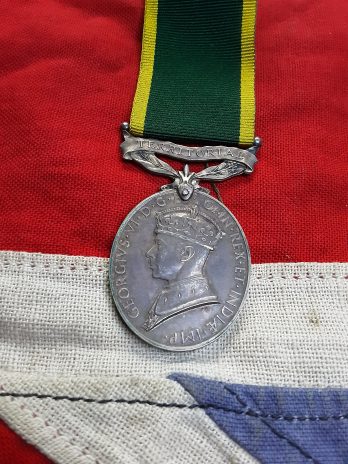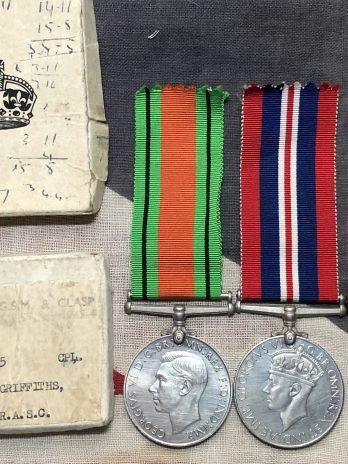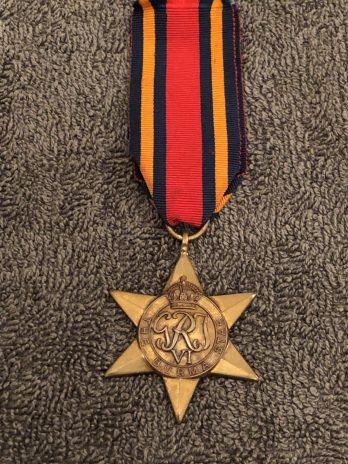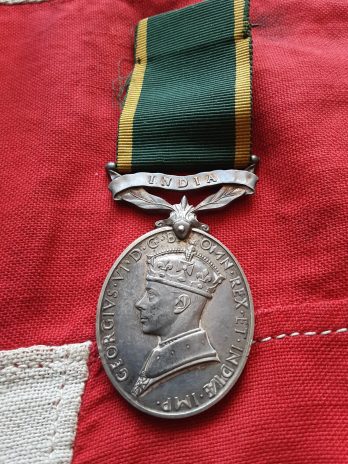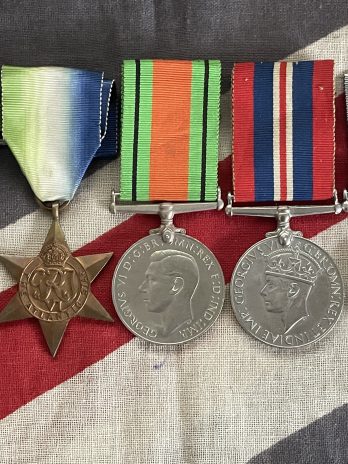WW2 group consisting of 39-45 Star, Atlantic Star, Defence Medal, War Medal and Royal Navy Long Service Good Conduct Medal.
Please look at the pictures to see the attempted erasure of details on the LSGC. Most of the naming has been removed but there is enough legible information to assert its recipient.
J107759 WAH Cumbers RN
William Albert Henry Cumbers was born in March 1907. We find an address in 1907 as 48 Palmerstor Road, Walthamstow and in 1911 for him as 56 Gainsford Road, Walthamstow.
He enlisted into the Royal Navy in March 1925. After his 12 year initial stint, he re-enlisted in 1929.
He married Daisy G Davenport in the first quarter of 1937.
He was posted to HMS Dorsetshire in September 1937 and was aboard her at the China Station when War was announced in 1939.
Admiral Graf Spee
At the start of the Second World War in September 1939, Dorsetshire was still on the China Station. In October, Dorsetshire, with other Royal Navy ships, was sent to South American waters in pursuit of the German heavy cruiser Admiral Graf Spee, which was attacking British merchant traffic in the area. Dorsetshire was assigned with her sister ship Cornwall and the aircraft carrier Eagle. Dorsetshire had just arrived in Simonstown, South Africa, from Colombo on 9 December, with orders to proceed to Tristan da Cunha and then to Port Stanley in the Falkland Islands to relieve Exeter. After departing Simonstown, she received the order to join the hunt for Admiral Graf Spee. She left South Africa on 13 December in company with the cruiser Shropshire and was in transit on 17 December when the Germans scuttled Admiral Graf Spee following the Battle of the River Plate. She escorted the damaged HMS Exeter back to the UK .
Bismark
In late May 1941, Dorsetshire was one of the ships deployed to hunt the German battleship Bismarck in the North Atlantic. Dorsetshire had been escorting convoy SL74 from Sierra Leone to the UK on 26 May, when she received the order to leave the convoy and join the search for Bismarck. She was some 360 nautical miles south of Bismarck‘s location. Dorsetshire steamed at top speed, though heavy seas later in the night forced her to reduce to 25 knots and later to 20 knots. By 08:33, Dorsetshire encountered the destroyer Cossack, which had been engaging Bismarck throughout the night. The German battleship’s gun flashes could be seen, only 6 nautical miles away, by 08:50.
Shortly thereafter, Dorsetshire took part in Bismarck‘s last battle. After the battleships Rodney and King George V neutralised Bismarck‘s main battery early in the engagement, Dorsetshire and other warships, including her sister HMS Norfolk, closed in to join the attack. Dorsetshire opened fire at a range of 20,000 yards, but poor visibility forced her to check her fire for lengthy periods. In the course of the engagement, she fired 254 shells from her main battery. In the final moments of the battle, she was ordered to move closer and torpedo Bismarck and fired three torpedoes, two of which hit the crippled battleship. The Germans had by this time detonated scuttling charges, which with the damage inflicted by the British, caused Bismarck to rapidly sink at 10:40.
Admiral John Tovey, the British commander, ordered Dorsetshire and the destroyer Maori to pick up survivors. A reported U-boat sighting forced the two ships to break off the rescue effort. Historians Holger Herwig and David Bercuson state that only 110 men were rescued, 85 aboard Dorsetshire and 25 aboard Maori. Historian Angus Konstam, however, writes that his research indicated a total of 116 saved, 86 on Dorsetshire (one of whom died), 25 on Maori, 3 rescued by U-74 and a further 2 picked up by the German weather ship Sachsenwald.
William served aboard HMS Dorsetshire from 1937 until 1941. He was awarded his LSGC in April 1940.
HMS Dorsetshire was later posted to the Eastern Fleet where she was sunk by the Japanese south west of Ceylon on the 5th April 1942.
William appears to have moved to Torquay and was living at 54 St Mary’s Church Road at the time of his death in 1980.
All medals have original ribbons.
Related products
-
WWII
Territorial Efficiency Medal. Watson. Royal Signals.
£50.00Original price was: £50.00.£47.00Current price is: £47.00. Add to basket -
WWII
East India Railway. India clasp, Efficient Service Medal. Doyle.
£160.00Original price was: £160.00.£145.00Current price is: £145.00. Add to basket


